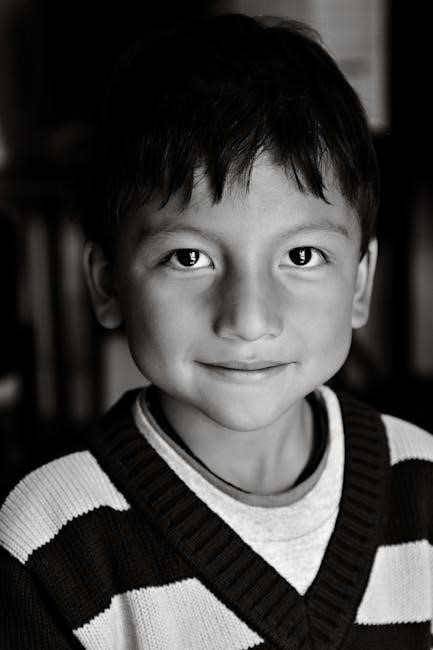Mona Hanna-Attisha’s What the Eyes Don’t See recounts the Flint water crisis, her crusade against lead poisoning, and the community’s resilience, available as an ebook, PDF, and audiobook.
Premise of the Book
What the Eyes Don’t See by Mona Hanna-Attisha chronicles the Flint water crisis, exposing how lead poisoning affected a city’s children. As a pediatrician, Mona uncovered the toxic truth, fought systemic negligence, and ignited a movement for justice. The book explores the intersection of environmental disaster, medical detective work, and community resilience, highlighting the importance of advocacy in public health crises.
Significance of the Title
The title What the Eyes Don’t See reflects Mona Hanna-Attisha’s belief that “the eyes don’t see what the mind doesn’t know,” inspired by D.H. Lawrence. It underscores the invisible lead poisoning crisis in Flint, hidden from public view, and the need for awareness and action to address environmental injustices and protect vulnerable communities from unseen threats.

About the Author: Mona Hanna-Attisha
Mona Hanna-Attisha, a pediatrician and public health advocate, exposed the Flint water crisis, inspiring a national conversation on environmental justice and children’s health through her work.
Background and Expertise
Mona Hanna-Attisha, a pediatrician and public health advocate, specializes in environmental health and child development. Her expertise in lead poisoning stems from extensive research and clinical practice, enabling her to identify and address the Flint water crisis effectively. Her work underscores the intersection of medicine and social justice, making her a leading voice in public health advocacy.
Inspiration Behind the Book
Mona Hanna-Attisha was inspired by the resilience of the Flint community, along with her commitment to environmental justice. The phrase “the eyes don’t see what the mind doesn’t know,” from D.H. Lawrence, motivated her to expose the truth and fight for justice.

The Crisis in Flint
The Flint water crisis began when the city switched to the Flint River, causing widespread lead contamination. Mona Hanna-Attisha’s research exposed the crisis, revealing the severe impact on children’s health.
Uncovering the Lead Poisoning
Mona Hanna-Attisha, inspired by the quote, “The eyes don’t see what the mind doesn’t know,” led the fight to expose Flint’s lead poisoning. She faced dismissals but persisted, using medical evidence to reveal elevated lead levels in children. Her research became the catalyst for addressing the crisis, ensuring accountability and safeguarding public health;
Initial Response and Challenges
Mona Hanna-Attisha faced dismissals and opposition when raising concerns about Flint’s water. Despite her medical expertise, authorities downplayed the issue, leading to delays in addressing the crisis. Mona had to fight for data transparency and credibility, emphasizing the importance of evidence-based action to protect children from lead poisoning.
Themes and Messages
The book highlights the fight for environmental justice, the power of community resistance, and the hope that emerges from crisis, emphasizing collective action and accountability.
Key Lessons from the Crisis
The Flint water crisis underscores the importance of environmental justice, highlighting systemic failures and the need for vigilant oversight. It also emphasizes the crucial role of community advocacy and scientific evidence in addressing public health emergencies. Mona Hanna-Attisha’s efforts reveal how collective action and persistence can drive meaningful change and protect vulnerable populations.
The Role of Resistance and Hope
Resistance and hope were pivotal in Flint’s recovery. Mona Hanna-Attisha’s relentless advocacy exemplifies how individuals can challenge systemic failings. The community’s resilience transformed despair into action, fostering hope for justice and safer living conditions. This collective effort highlights the power of unity and determination in overcoming adversity and rebuilding trust.
Key Events and Turning Points
Mona Hanna-Attisha’s investigation exposed Flint’s lead poisoning, sparking national outrage and prompting emergency responses, marking a turning point in the city’s fight for justice and recovery.
Exposure of the Crisis
Mona Hanna-Attisha’s meticulous data analysis revealed alarming lead levels in Flint’s children, prompting her to courageously expose the crisis despite initial disbelief. Her findings sparked widespread media attention, forcing officials to acknowledge the contamination and triggering a national outcry. This pivotal moment highlighted the power of scientific advocacy and community voices in uncovering systemic failures;
Community Reaction and Mobilization
Flint residents, already grappling with economic hardship, were devastated by the lead poisoning revelation. Grassroots movements emerged, with citizens demanding accountability and solutions. Mona Hanna-Attisha’s work became a rallying cry, uniting the community and inspiring collective action. Their resilience and determination laid the groundwork for systemic change, proving that even in crises, hope and activism can drive transformation.
Reception and Reviews
Mona Hanna-Attisha’s work received critical acclaim for its gripping narrative and advocacy. It won the 2018 Cherri Foytlin Award, becoming a widely downloaded and impactful PDF.
Critical Acclaim
What the Eyes Don’t See has garnered widespread praise for its vivid storytelling and urgent message. Reviewers highlight Mona Hanna-Attisha’s courage and insight, calling it a “riveting account of a shameful disaster turned into a tale of hope.” The book has been celebrated for its ability to blend personal narrative with policy critique, resonating deeply with readers and experts alike.
Awards and Recognition
Mona Hanna-Attisha’s work in What the Eyes Don’t See has earned notable recognition. The book received the One World Award and was featured on several “Best Books” lists. Mona’s efforts were also acknowledged with the Heinz Award and a spot in Time Magazine’s 100 Most Influential People, solidifying her impact as both a writer and a public health advocate.

Availability and Formats
Mona Hanna-Attisha’s What the Eyes Don’t See is available as an ebook, PDF, and audiobook. It can be purchased on platforms like Amazon, Barnes & Noble, and Google Books.
Editions and Publishing Details
The book What the Eyes Don’t See is part of the One World Essentials series, published by Random House. It was released in June 2018 and spans 312 pages. Available formats include hardcover, paperback, ebook, and audiobook, ensuring accessibility for diverse readers. The PDF version is also widely accessible for digital readers.
Where to Purchase
What the Eyes Don’t See is available for purchase through major online retailers like Amazon, Barnes & Noble, and IndieBound. The PDF version can be downloaded from platforms such as Google Books and Apple Books. Hardcover, paperback, and audiobook editions are also accessible via Book Depository and Penguin Random House’s official website.

Downloading the PDF
The PDF version of What the Eyes Don’t See can be downloaded from platforms like Amazon, Google Books, and Apple Books. Ensure to use authorized sources for legal access.
Process and Sources
To download the PDF of What the Eyes Don’t See, visit authorized platforms like Google Books, Apple Books, or Amazon. Ensure the source is legal to avoid copyright issues. The PDF is also available through services like Litres, offering multiple formats. Use ISBN-13: 978-0525509025 to locate the book. Always verify the publisher, One World Publications, for authenticity and quality downloads.
Considerations for Access
Accessing the PDF of What the Eyes Don’t See requires a valid purchase or subscription. Platforms like Amazon, Google Books, and Litres offer digital copies. Ensure your device supports PDF formats and has adequate storage. Free downloads may infringe on copyright laws, so prioritize legal sources to support the author and publisher. Always verify the file’s safety before downloading.

Related Books and Resources
Books like Behind Her Eyes by Sarah Pinborough and The Immortal Life of Henrietta Lacks offer similar themes of crisis, hope, and scientific discovery, complementing What the Eyes Don’t See.
Similar Works
Books like Behind Her Eyes by Sarah Pinborough and The Immortal Life of Henrietta Lacks by Rebecca Skloot explore similar themes of societal crises, scientific discovery, and human resilience. These works complement What the Eyes Don’t See by offering deeper insights into justice, health, and community strength, making them great recommendations for readers seeking comparable narratives.
Further Reading
For deeper insights, readers can explore Things the Eye Can’t See by Sándor Márai and Just the Way You Are by Bruno Mars, which delve into societal issues and human emotion. These works, like Mona Hanna-Attisha’s, highlight the power of storytelling in addressing crises, offering a rich tapestry of perspectives on justice, health, and community resilience;
Historical Context
The Flint water crisis reflects broader environmental justice issues in America, echoing past crises where systemic neglect disproportionately harmed marginalized communities, highlighting the need for accountability and reform.
Environmental Justice in America
The Flint water crisis symbolizes a broader pattern of environmental neglect harming marginalized communities. Historically, low-income and minority neighborhoods face disproportionate exposure to pollutants, reflecting systemic racism and inequality. Mona Hanna-Attisha’s work underscores the urgency of addressing these disparities, advocating for equitable solutions to ensure clean water and air for all, as highlighted in What the Eyes Don’t See.
Previous Crises and Lessons
Historical environmental disasters, like Love Canal and the water crisis in Flint, reveal recurring themes of negligence and systemic injustice. These events highlight the importance of community advocacy and the need for accountability. Mona Hanna-Attisha’s work in What the Eyes Don’t See draws parallels, emphasizing lessons learned to prevent future crises and protect vulnerable populations from environmental harm.
Scientific Aspects
Lead poisoning disrupts brain and nervous system development, causing irreversible damage. Mona Hanna-Attisha’s research revealed elevated lead levels in Flint’s children, emphasizing the urgency of scientific intervention and data-driven solutions to combat public health crises effectively.
Lead Poisoning Effects
Lead poisoning causes irreversible brain damage, developmental delays, and behavioral issues. Mona Hanna-Attisha’s research revealed elevated lead levels in Flint’s children, highlighting the devastating impact on their long-term health and cognitive abilities, emphasizing the urgency of early intervention and prevention strategies to mitigate these effects on vulnerable populations, particularly children.
Medical and Scientific Insights
Mona Hanna-Attisha’s expertise as a pediatrician and public health advocate shines through her meticulous analysis of blood lead levels in Flint’s children. Her research revealed the extent of contamination and its profound impact on health, emphasizing the importance of early intervention and evidence-based policy changes to protect vulnerable populations from environmental hazards.

Community Impact
The Flint water crisis deeply affected residents, causing widespread socioeconomic distress and long-term health implications, particularly for children exposed to lead, as highlighted in Mona Hanna-Attisha’s work.
Socioeconomic Effects
The Flint water crisis exacerbated existing socioeconomic disparities, with low-income families disproportionately affected. Increased healthcare costs, reduced property values, and a strained local economy further burdened the community, as detailed in Mona Hanna-Attisha’s What the Eyes Don’t See, highlighting the long-term financial and social challenges faced by residents.
Long-term Health Implications
The Flint water crisis led to severe long-term health impacts, particularly for children, due to lead poisoning. Developmental delays, learning disabilities, and behavioral issues persisted, as highlighted in What the Eyes Don’t See. The toxic effects of lead caused irreversible damage, underscoring the critical need for early intervention and ongoing medical care to mitigate these lifelong challenges.
Personal Stories
What the Eyes Don’t See shares heartfelt accounts of Flint residents, revealing their struggles with lead poisoning and resilience. Mona Hanna-Attisha’s narrative highlights individual journeys, emphasizing the human cost of the crisis and the power of community strength in the face of adversity.
Individual Accounts
What the Eyes Don’t See vividly captures personal tales of Flint’s residents, detailing their battles with lead poisoning. Mona Hanna-Attisha weaves together stories of courage and loss, offering a poignant look at how the crisis affected families and children, while highlighting their resilience and determination to rebuild their lives amidst the chaos.
Human Impact
What the Eyes Don’t See poignantly illustrates the profound human toll of the Flint water crisis, revealing how lead poisoning affected children’s health, development, and futures. The book highlights the emotional and physical struggles faced by families, emphasizing the long-term consequences of environmental negligence and the collective trauma experienced by the community.

The Role of Activism
What the Eyes Don’t See highlights Mona Hanna-Attisha’s activism, showcasing her relentless fight for justice in Flint. Grassroots movements and community efforts were pivotal in exposing the crisis and driving change, proving the power of collective action against systemic negligence.
Grassroots Movements
Grassroots movements played a vital role in exposing the Flint water crisis. Residents, activists, and local organizations collectively pushed for accountability, raising awareness and demanding action. Mona Hanna-Attisha’s efforts were amplified by these movements, which became the backbone of the resistance, proving that community-driven initiatives can lead to significant change and justice.
Policy Changes
The Flint water crisis led to significant policy changes, tightening regulations on water safety and accountability. New measures ensured stricter oversight of water systems, while accountability for public officials was heightened. These changes reflect a broader shift toward prioritizing environmental justice and public health, aiming to prevent similar crises in the future.
Legacy and Influence
The book has left a lasting impact, inspiring advocacy and prompting national reforms. It stands as a testament to community resilience and the power of collective action.
Impact on Policy
The book exposed systemic failures, prompting stricter water safety regulations and accountability measures. It inspired federal and state reforms, ensuring safer drinking water and healthier communities nationwide.
Future Implications
The Flint water crisis highlights the need for vigilant oversight of public health systems. Mona Hanna-Attisha’s work underscores the importance of advocacy and transparency in preventing future environmental disasters. The book serves as a call to action, inspiring communities to demand accountability and ensure safe living conditions for all, particularly vulnerable populations.
Mona Hanna-Attisha’s What the Eyes Don’t See emphasizes the power of advocacy and justice, urging readers to remain vigilant against systemic failures and environmental neglect.
Final Thoughts
What the Eyes Don’t See leaves readers with a profound understanding of the Flint water crisis, highlighting the importance of community, justice, and accountability. Mona Hanna-Attisha’s work underscores the need for vigilance and advocacy in protecting vulnerable populations. Available as an ebook and PDF, it serves as a call to action for systemic change and environmental justice.
Call to Action
Read Mona Hanna-Attisha’s What the Eyes Don’t See to understand the Flint water crisis and its lessons on justice. Download the PDF or ebook to explore her journey of resistance and hope. Advocate for environmental justice, support affected communities, and demand accountability for systemic failures. This story inspires action and reminds us that collective effort can drive meaningful change for a better future.
